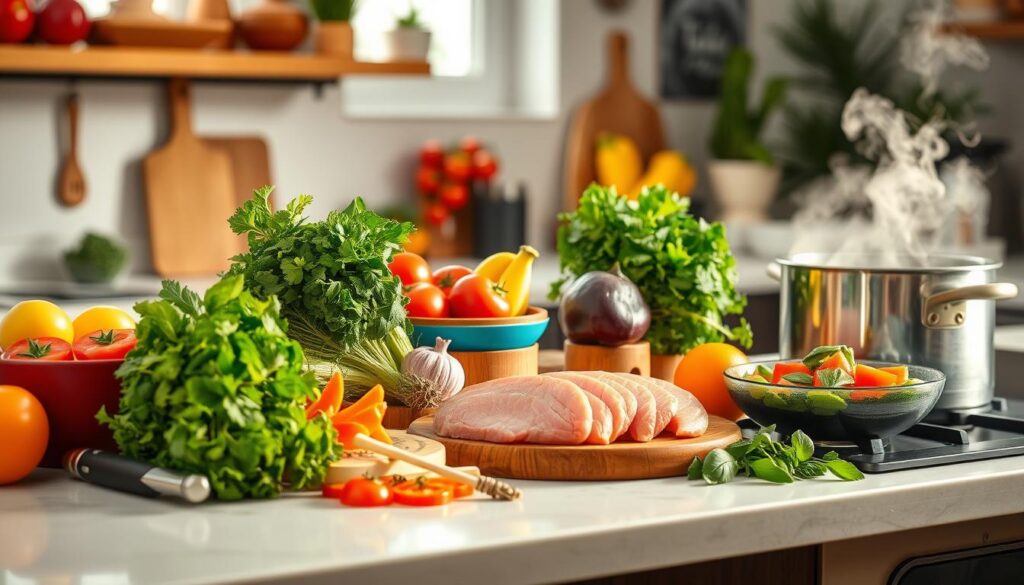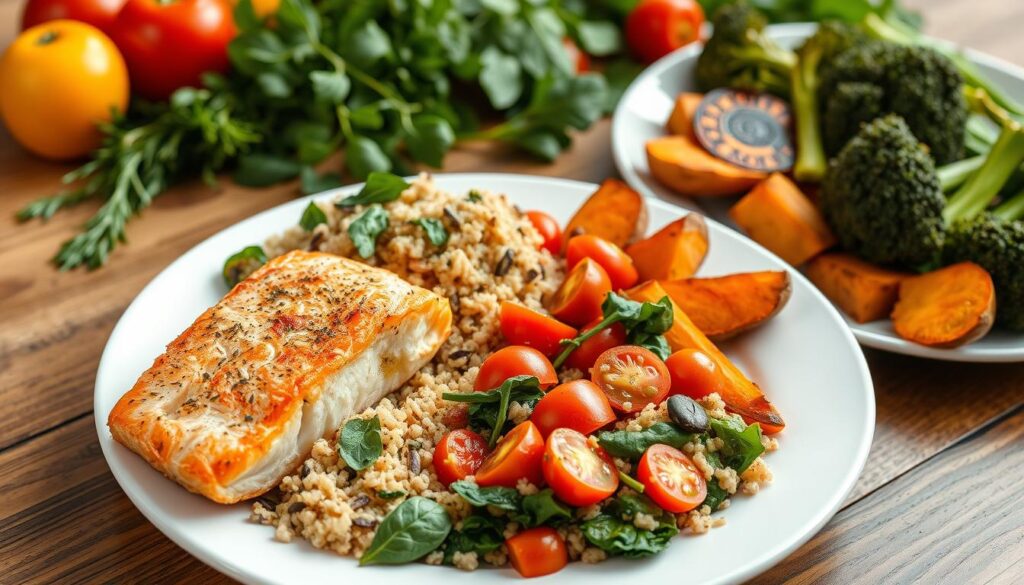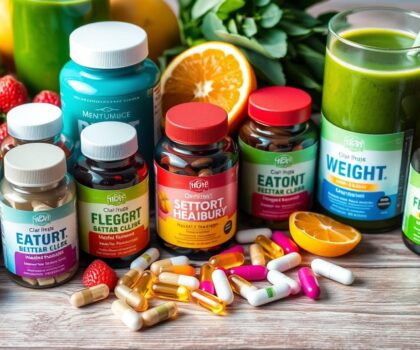Did you know over 100 quick healthy dinners can be made in under 30 minutes? This is great news for busy people and families. It turns mealtime into a fun experience.
With 30 easy healthy recipes, you can make nutritious meals without spending hours cooking. Try a Honey Sesame Chicken Meal Prep Bowl in just 30 minutes. Or, make a Hot Honey Chickpea Bowl in 20 minutes or less. These recipes are quick, delicious, and fit many tastes and diets.
Each recipe uses wholesome ingredients and simple cooking methods. This makes them perfect for both beginners and experienced cooks.

Trying these healthy dinner ideas can make your weeknights easier. They also help you eat better. You’ll find everything from colorful salads to comforting pasta dishes. There’s something for everyone.
Ready to explore the world of quick and healthy cooking? Let’s get started!
Key Takeaways
- Over 100 quick healthy dinner options available.
- Recipes are designed for 20 to 30 minutes preparation.
- Wholesome ingredients enhance nutrition and taste.
- Easily adaptable recipes for various dietary preferences.
- Simple cooking techniques for beginners.
Introduction to Easy Healthy Dinner Recipes
In today’s fast world, easy healthy dinner recipes are key to a balanced diet. They help us eat well without the stress of complicated cooking. These recipes show that healthy eating is simple and fun, even with a busy schedule.
Many of these recipes can be made in 30 minutes or less. They include quick stir-fries and baked dishes that are both tasty and healthy. You can also make them your own by trying different ingredients and flavors.
This guide will cover the benefits of healthy cooking and the ingredients you need. It’s perfect for both beginners and cooking enthusiasts. Discover simple, tasty recipes that make dinner time special and focus on good nutrition.
Benefits of Healthy Cooking
Healthy cooking does more than just fill our bellies. It boosts nutrition and helps with weight management. Cooking at home lets us control what we eat, improving our mood, energy, and immune system.
Improved Nutrition
Healthy cooking means using whole foods and avoiding processed ones. This reduces sugar and unhealthy fats. People who cook often eat fewer calories and less sugar.
They also make better choices when eating out. Adding frozen veggies or canned beans to recipes makes meals healthier and quicker to prepare.
Weight Management
Cooking at home helps with weight control. It saves money and lets us control portion sizes. This way, we can eat tasty, healthy meals without gaining weight.
Studies show that cooking most nights a week keeps us at a healthy weight. A balanced meal with veggies, proteins, and grains supports our weight goals.
| Aspect | Home Cooking Benefits | Dining Out Risks |
|---|---|---|
| Nutrition | Focus on whole ingredients, reduced processed foods | Higher calorie counts, unhealthy additives |
| Cost | Save approximately $60 monthly | Increased food expenses |
| Health | Lower risk of heart disease, diabetes | Higher likelihood of unhealthy meal choices |
| Psychological | Stress relief, improved mindset | Potential for increased stress from external food choices |
Essential Ingredients for Healthy Dinners
Making a healthy dinner is easy. Use lean proteins, whole grains, and fruits and vegetables to make meals tasty and nutritious. These ingredients add flavor and nutrients, making cooking fun.
Lean Proteins
Lean proteins help muscles grow and repair. Good choices are chicken breast, canned salmon, and legumes like chickpeas or lentils. They’re healthy and can be used in many recipes.
For example, grilled chicken goes well with leafy greens or in a salad with berries. This makes for a meal full of nutrients.
Whole Grains
Whole grains are rich in fiber, which helps digestion and keeps you full. Try brown rice, quinoa, and whole rolled oats in your meals. A quinoa bowl with roasted veggies is a tasty and healthy option.
Having whole grains ready means you can make meals that are both filling and nutritious.
Fruits and Vegetables
Fruits and vegetables add color and flavor to any dish. Use fresh, frozen, or canned options for convenience. Frozen spinach, for example, boosts a pasta dish with folate.
Adding crunchy veggies like carrots and broccoli to stir-fries or salads makes meals vibrant and nutritious. Seasonal produce also sparks creativity, leading to new flavors and textures.
Healthy Cooking Techniques
Using the right cooking methods can make meals healthier. Techniques like steaming and sautéing keep vitamins and minerals intact. This way, you get tasty, nutritious dishes without too many calories.
Steaming and Sautéing
Steaming is great for veggies, keeping them colorful and full of nutrients. It doesn’t need any extra fats. Sautéing, with a bit of oil, brings out rich flavors. Choosing the right oil and amount helps keep your meal healthy and flavorful.
Grilling versus Frying
Grilling adds a smoky taste and is better than frying. It’s healthier because it doesn’t add unhealthy fats. Air frying is a good alternative to frying, offering a crispy texture with less oil. Choosing grilling over frying helps make meals that are good for you and taste great.
| Cooking Method | Nutritional Benefits | Flavor Profile |
|---|---|---|
| Steaming | Preserves vitamins and minerals | Light and fresh |
| Sautéing | Enhances flavor with minimal oil | Rich and savory |
| Grilling | Reduces fat while adding smoky flavor | Smoky and caramelized |
| Frying | Can introduce unhealthy fats | Crispy and indulgent |
By using these healthy cooking methods, you can make meals that are both satisfying and good for you.
30 Quick Dinner Recipes to Try
Busy evenings need quick dinner recipes that are healthy. This collection of 30 recipes is fast and nutritious. They use whole ingredients and are easy to make in 30 minutes or less.
Try different proteins like chicken, shrimp, lean ground beef, and salmon. Stir-frying and broiling make cooking easy. Some recipes add grapefruit and chile salsa for extra flavor.
These meals are good for everyone, with options for dairy-free and low-fat diets. Using rotisserie chicken or frozen shrimp makes them quicker. You’ll find dishes from Greek, Latin American, Chinese, and Spanish cuisines. They’re packed with healthy ingredients like chickpeas, leafy greens, and avocado.
Here’s a table summarizing the cooking times and main ingredients for a range of selected recipes:
| Recipe Name | Cooking Time (minutes) | Main Ingredients | Skill Level |
|---|---|---|---|
| Salmon Pasta | 30 | Salmon, Spaghetti, Avocado | Beginner |
| Chickpea Stir-Fry | 20 | Chickpeas, Vegetables, Soy Sauce | Beginner |
| Vegetable Fried Rice | 25 | Rice, Mixed Vegetables, Eggs | Intermediate |
| Pork Tenderloin with Balsamic Glaze | 30 | Pork Tenderloin, Balsamic Vinegar, Garlic | Intermediate |
| Shrimp Tacos with Salsa | 30 | Shrimp, Tortillas, Chile Salsa | Beginner |
These quick dinner recipes save time and add flavor, texture, and color to meals. They make healthy eating fun for the whole family.
Healthy Cooking Recipes for Beginners
Starting in the kitchen can be fun and tasty. Simple dishes like easy chicken stir-fry are great for beginners. They use fresh ingredients and mix nutrition with flavor, making cooking rewarding.
Easy Chicken Stir-Fry
This dish is perfect for beginners. It takes about 20 minutes to make. It combines lean chicken with colorful veggies, adding protein and vitamins.
A splash of soy sauce and sesame seeds make it savory. This recipe lets you try different veggies and spices as you get better.
Simple Quinoa Bowls
Quinoa bowls are great for beginners because you can customize them. Start with basic quinoa and add toppings like roasted veggies or chickpeas. They’re flexible for different diets and tastes.
In about 30 minutes, you can make a nutritious bowl. It’s perfect for lunch or dinner.
One-Pan Sausage and Veggies
One-pan meals are a big help for those who hate cleaning up. This dish combines sausage with veggies in the oven. It’s easy and makes flavors better through roasting.
In 25 minutes, you can make a tasty meal with little effort. It makes dinner easy and satisfying.
| Recipe Name | Prep Time | Cooking Time | Main Ingredients |
|---|---|---|---|
| Easy Chicken Stir-Fry | 5 minutes | 20 minutes | Chicken, vegetables, soy sauce |
| Simple Quinoa Bowls | 10 minutes | 20 minutes | Quinoa, vegetables, chickpeas |
| One-Pan Sausage and Veggies | 10 minutes | 15 minutes | Sausage, seasonal vegetables |
These recipes are a great start for beginners. They introduce healthy cooking and encourage creativity. With these easy meals, you can enjoy cooking for years to come.
Incorporating Vegetables into Your Meals
Most Americans don’t eat enough vegetables. It’s key to find fun ways to add them to meals. By trying new vegetables and cooking methods, meals can be tasty and healthy. Adding veggies boosts flavor and nutrition, helping you eat well.
Creative Ways to Add Greens
There are many ways to add greens to your day. Adding spinach to smoothies is a great way to get more nutrients without changing taste. Frozen mixed veggies are easy to use with rice or sweet potatoes. These options fit well into any meal.
Make Food Colorful with Fresh Produce
Colorful meals are not only pretty but also nutritious. Mixing carrots, broccoli, and zucchini in stir-fries makes a vibrant dish. Roasting or grilling veggies adds flavor and texture. It makes meals more fun and exciting.
| Vegetable | Preparation Method | Dish Suggestions |
|---|---|---|
| Spinach | Raw or blended | Smoothies, salads |
| Broccoli | Steamed or roasted | Stir-fries, bowls |
| Zucchini | Spiralized or grilled | Pasta substitutes, salads |
| Cauliflower | Buffalo wings or rice | Appetizers, side dishes |
| Mixed Vegetables | Frozen or canned | Rice bowls, casseroles |
Adding veggies to meals is good for your diet and cooking skills. Trying different veggies makes healthy eating fun and tasty. It’s great for your health and well-being.
Strategies for Meal Prepping
Meal prepping is a smart way to enjoy healthy meals all week. It means making food for 3-7 days to make busy weeks easier. Planning meals and making grocery lists ahead of time makes shopping simpler.
Planning Your Weekly Meals
Creating a weekly meal plan is key for meal prepping. Start with easy recipes and add more as you get better. Begin with 2-3 meals to start.
Choose meals that have protein, grains, and veggies for a balanced diet. Grains, beans, roasted veggies, and proteins are great for batch cooking. They make quick dinners easy.
Batch Cooking Basics
Batch cooking means making lots of food at once. Use containers like plastic, glass, or metal bento boxes for storage. Avoid soft fruits and fried foods for meal prep.
Use microwave-safe containers and Mason jar salads to keep food fresh. The FDA says to refrigerate meals and not prep more than four days at a time. This helps reduce decision fatigue and supports healthy eating.
| Food Item | Prep Suitability | Storage Duration |
|---|---|---|
| Grains | Suitable | 3-4 days |
| Fried Foods | Not Suitable | N/A |
| Roasted Vegetables | Suitable | 3-4 days |
| Soft Fruits | Not Suitable | N/A |
| Proteins | Suitable | 3-4 days |
Try new meal prep ideas and share tips to improve your experience. Spend a few hours on prep days like Sundays or Wednesdays. This makes sticking to healthy habits easier.
Meal prepping saves time and makes life more organized. It’s a great way to manage your week.
Tips for Cooking with Kids
Getting kids involved in the kitchen makes mealtime fun. It teaches them about healthy eating and helps them learn new skills. Starting early makes cooking a fun activity for toddlers.
Letting them do small tasks, like measuring or cracking eggs, sparks their interest in food.
As kids get older, they can do more. Preschoolers can help with tasks like washing grapes. This helps them learn and follow kitchen rules.

Kids aged 6 to 8 can do more on their own. They can make sandwiches or salads. This age group learns about food, nutrition, and staying hydrated.
Talking to them while cooking helps their communication skills.
Statistics show how good cooking with kids is:
- 75% of children improve their math skills when involved in cooking activities.
- 90% of parents note that cooking with kids teaches patience.
- 85% of families find cooking together to be a fun and engaging experience.
- Encouraging kids to choose what to cook can increase their participation by 70%.
- Using cookie cutters can boost vegetable consumption by 50%.
- Proper handwashing significantly increases hygiene compliance by 80%.
- Engaging children in meal prep can lead to a 60% increase in their willingness to try new foods.
Cooking with kids creates lasting memories and teaches them about food. Each time, it’s a chance for growth, learning, and fun.
Healthy Dinner Ideas for Specific Diets
Dinner ideas that fit specific diets are more important than ever. Whether you’re looking for vegetarian meals or following paleo recipes, there’s a lot to choose from. These meals are not only healthy but also delicious.
Vegetarian Quick Meals
Vegetarian dinners are great for those who love plants. They’re easy to make and full of nutrients. Here are some tasty options:
- Chickpea curry, made with tomatoes and spices, is packed with protein and taste.
- Stuffed bell peppers with quinoa, black beans, and cheese are a mix of textures.
- Pasta primavera with fresh veggies is light but filling.
These meals are not just tasty but also good for you. They show the value of using a variety of ingredients.
Paleo-Friendly Dinner Options
For those on the paleo diet, there are many tasty meals. Here are some paleo recipes:
- Grilled chicken thighs with roasted veggies make a savory dish.
- Stuffed zucchini boats with ground turkey and spices are hearty and healthy.
- Pan-seared salmon with asparagus is quick, flavorful, and nutritious.
These recipes focus on whole foods and avoid processed stuff. They’re ideal for those following the paleo diet.
| Dish | Diet Type | Preparation Time |
|---|---|---|
| Chickpea Curry | Vegetarian | 20 mins |
| Stuffed Bell Peppers | Vegetarian | 30 mins |
| Grilled Chicken Thighs | Paleo | 25 mins |
| Stuffed Zucchini Boats | Paleo | 20 mins |
These diverse meal ideas help everyone find something they like. Keep trying new recipes to make healthy cooking a part of your daily routine.
Using Seasonal Ingredients
Seasonal cooking makes meals taste better and is good for the planet. It lets us enjoy the best flavors and health benefits of fresh produce. Buying what’s in season saves money and supports local farmers.
Benefits of Cooking with Seasonal Produce
Seasonal cooking has many perks. Here are some key benefits:
- Enhanced Flavor: Produce at its peak is more flavorful than out-of-season options.
- Higher Nutritional Value: Fresh produce has more nutrients since it’s picked sooner.
- Cost Efficiency: Seasonal items are often cheaper because they’re in abundance.
- Support for Local Farmers: Buying local helps the community and supports sustainability.
How to Choose Fresh Ingredients
Choosing the right ingredients is key to tasty and healthy meals. Here are some tips:
- Visit Local Farmers’ Markets: Talk to farmers to find the freshest produce.
- Examine Color and Texture: Bright colors and firm textures mean quality.
- Understand Seasonality: Use seasonal calendars to know what’s in season.
- Check for Ripeness: Pick items that are ripe but not too ripe for the best taste.
Using seasonal ingredients leads to delicious meals. It’s good for our health and supports local farmers. This approach to cooking is all about enjoying fresh, healthy food while helping our community.
How to Keep Dinner Healthy and Flavorful
It’s possible to make dinner both healthy and tasty. Using herbs and spices is a great way to do this. They add flavor without extra calories or unhealthy stuff. Herbs like basil, rosemary, and cilantro not only taste good but also pack nutrients.
Ingredients like tomatoes and mushrooms add a lot of flavor. They make healthy meals taste amazing. Try making marinades and dressings with olive oil, lemon juice, and balsamic vinegar. These can make veggies and proteins taste great.
For easier meal prep, follow some tips for healthy meals. Meal planning helps avoid waste and makes shopping easier. Cooking in bulk and freezing meals means you always have something quick to eat. Frozen fruits and veggies are just as healthy as fresh ones.

Make sure your plates are colorful and balanced. Include proteins, grains, and veggies for a meal that’s both healthy and flavorful. Grilling and roasting are good ways to cook that keep nutrients in and flavors up.
Being flexible in the kitchen makes cooking fun. Some nights, you might want something quick but still healthy. Finding the right balance between effort and flavor ensures every dinner is delicious and good for you.
Conclusion
Exploring easy healthy dinner recipes shows how important they are for everyone. They make cooking nutritious meals simple and fun. By adding quick healthy meals to our daily lives, we improve our eating habits and enjoy tasty, healthy food.
Recipes like Roasted Vegetables and Sausage, and Instant Pot Buffalo Chicken Chili make cooking easy and rewarding. This makes it simple to prepare healthy dinners.
Dinner can be a time for creativity and family bonding. Cooking together brings families closer. Freezing leftovers also helps, making sure we always have healthy food ready.
Trying 24 different recipes over ten months shows how easy it is to mix up meals. We can add flavors from around the world to our dishes while keeping them healthy.
There are many dishes and ingredients to try, from salmon burgers to international flavors. We’re encouraged to explore and share our cooking adventures. This way, healthy eating becomes a fun part of our lives.



